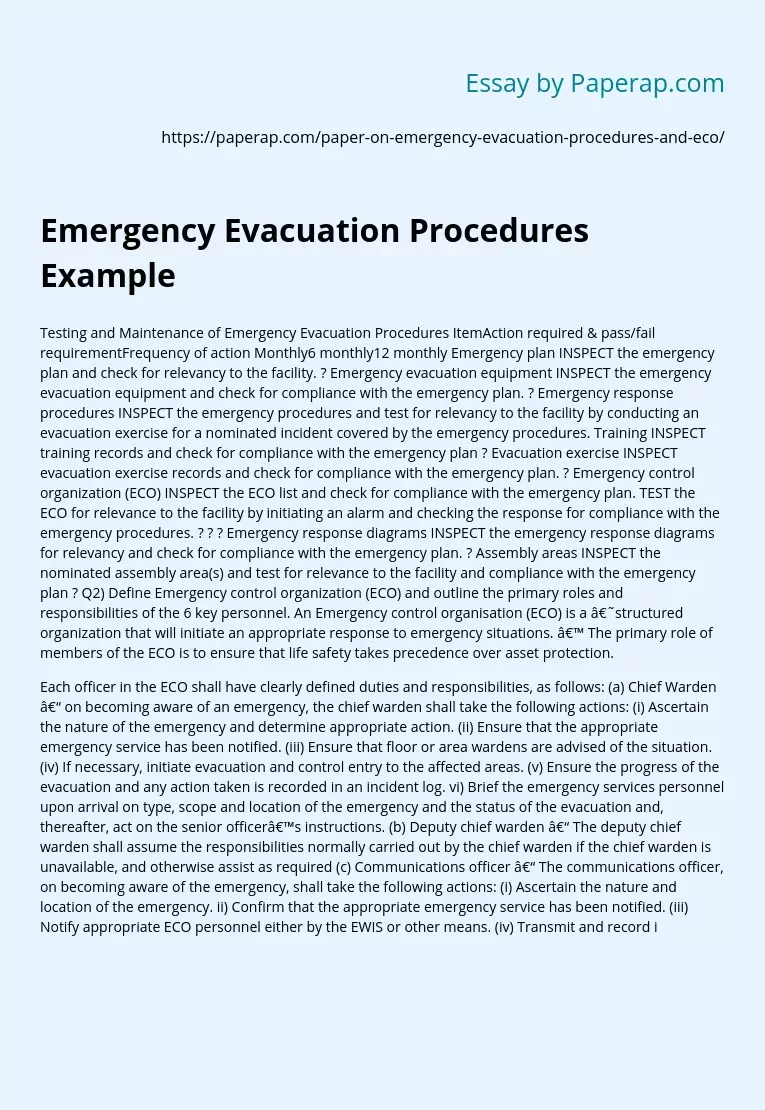Emergency Evacuation Procedures Example
Testing and Maintenance of Emergency Evacuation Procedures ItemAction required & pass/fail requirementFrequency of action Monthly6 monthly12 monthly Emergency plan INSPECT the emergency plan and check for relevancy to the facility. ? Emergency evacuation equipment INSPECT the emergency evacuation equipment and check for compliance with the emergency plan.
? Emergency response procedures INSPECT the emergency procedures and test for relevancy to the facility by conducting an evacuation exercise for a nominated incident covered by the emergency procedures. Training INSPECT training records and check for compliance with the emergency plan ? Evacuation exercise INSPECT evacuation exercise records and check for compliance with the emergency plan. ? Emergency control organization (ECO) INSPECT the ECO list and check for compliance with the emergency plan. TEST the ECO for relevance to the facility by initiating an alarm and checking the response for compliance with the emergency procedures. ? ? ? Emergency response diagrams INSPECT the emergency response diagrams for relevancy and check for compliance with the emergency plan. ? Assembly areas INSPECT the nominated assembly area(s) and test for relevance to the facility and compliance with the emergency plan ? Q2) Define Emergency control organization (ECO) and outline the primary roles and responsibilities of the 6 key personnel.
An Emergency control organisation (ECO) is a ‘structured organization that will initiate an appropriate response to emergency situations. ’ The primary role of members of the ECO is to ensure that life safety takes precedence over asset protection.
Each officer in the ECO shall have clearly defined duties and responsibilities, as follows: (a) Chief Warden – on becoming aware of an emergency, the chief warden shall take the following actions: (i) Ascertain the nature of the emergency and determine appropriate action.
(ii) Ensure that the appropriate emergency service has been notified. (iii) Ensure that floor or area wardens are advised of the situation. (iv) If necessary, initiate evacuation and control entry to the affected areas. (v) Ensure the progress of the evacuation and any action taken is recorded in an incident log. vi) Brief the emergency services personnel upon arrival on type, scope and location of the emergency and the status of the evacuation and, thereafter, act on the senior officer’s instructions. (b) Deputy chief warden – The deputy chief warden shall assume the responsibilities normally carried out by the chief warden if the chief warden is unavailable, and otherwise assist as required (c) Communications officer – The communications officer, on becoming aware of the emergency, shall take the following actions: (i) Ascertain the nature and location of the emergency. ii) Confirm that the appropriate emergency service has been notified. (iii) Notify appropriate ECO personnel either by the EWIS or other means. (iv) Transmit and record instructions and information between the chief warden and the floor wardens and occupants. (v) Maintain a log of the events. (vi) Act as directed by the chief warden. (d) Floor or area wardens – On hearing an alarm or on becoming aware of an emergency, the floor or area wardens shall take the following actions: (i) Implement the emergency procedures for their floor or area. ii) Ensure that the appropriate emergency service has been notified. (iii) Direct wardens to check the floor or area for any abnormal situation. (iv) Commence evacuation if the circumstances on their floor or area warrant this. (v) Communicate with the chief warden by whatever means available and act on instructions. (vi) Advise the chief warden as soon as possible of the circumstances and action taken. (vii) Co-opt persons as required to assist a warden during an emergency. (viii) Confirm that the activities of wardens have been completed and report this to the chief warden. e) Wardens Persons – selected as wardens may be required to carry out a number of activities, including the following: (i) Act as floor or area wardens. (ii) Ensure that the appropriate emergency service has been notified. (iii) Operate the intercommunication system. (iv) Check to ensure fire doors and smoke doors are properly closed. (v) Search the floor or area to ensure all persons have evacuated. (vi) Ensure orderly flow of persons into protected areas, e. g. stairwells. (vii) Assist persons with disabilities. (viii) Act as leader of groups moving to nominated assembly areas. ix) Report to the floor or area warden on completion of required activities. Q3) Using data from the relevant Australian Standard as a guide, describe the procedure used to pressure test a delivery lay flat fire hose. (a) Lay the hose out straight on a flat clean surface. (b) Mark the hose/coupling joints so that any movement between the two will be obvious. (c) Fasten the hose ends, to limit movement in the event of rupture. (d) Charge the hose with water to a nominal pressure of 500 kPa, taking care to vent all air. e) Increase the pressure gradually, over a period of not less than 20 s and not more than 2 min, until the required maximum working pressure is reached. (f) Maintain the maximum working pressure for a period of not less than 3 min, while the hose is examined for defects. Bibliography AS 3745 Emergency control organization and procedures for buildings, structures and workplaces AS/NZS 3003:2003 Electrical installations – Patient areas of hospitals, medical and dental practices and dialyzing locations AS 1851. 9—1997 Maintenance of fire protection Equipment Part 9: Delivery lay flat fire hose
Emergency Evacuation Procedure Example
Emergency Evacuation Procedures Example. (2019, Dec 05). Retrieved from https://paperap.com/paper-on-emergency-evacuation-procedures-and-eco/

